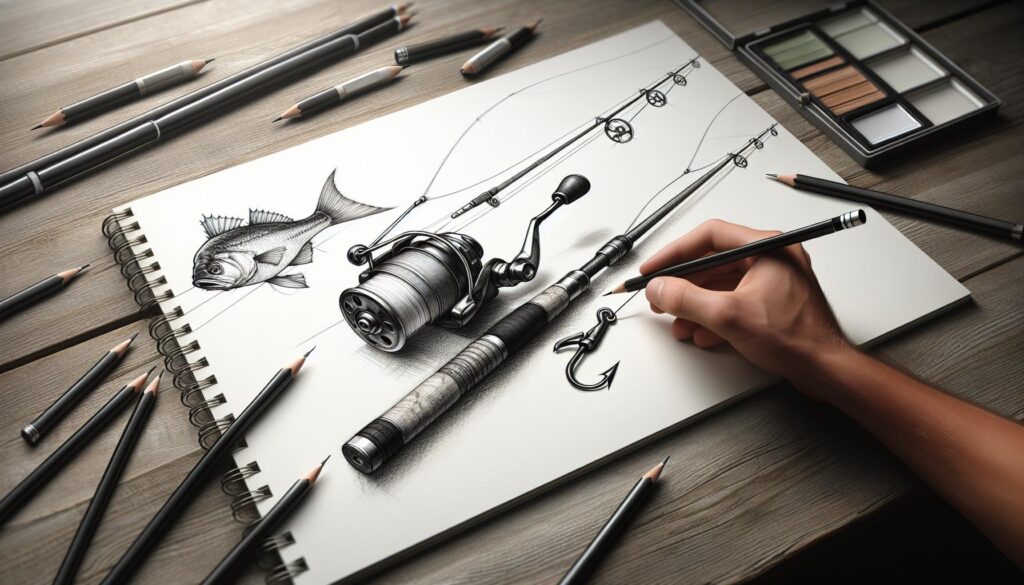To draw a fishing pole, first, start with a straight line for the main body and add a smaller line at an angle for the reel. Then, draw two rectangles for the handle and a triangle for the fishing hook.
Finally, add details like fishing line and guide rings. Now, let’s delve into the steps of drawing a fishing pole in more detail. Fishing is a popular outdoor activity enjoyed by many people around the world. Whether you are a seasoned angler or just starting out, knowing how to draw a fishing pole can be a fun and useful skill.
Drawing a fishing pole is relatively simple, and with a few easy steps, you can create a realistic-looking picture. In this guide, we will take you through the process of drawing a fishing pole in a step-by-step manner, so you can create your own detailed and accurate illustration. So, grab a pen and paper, and let’s get started on this artistic journey of capturing the essence of fishing.
Table of Contents
* Importance Of Sketching In Fishing
Sketching plays a crucial role in fishing as it enhances understanding of the equipment and improves accuracy in replicating details. By sketching, anglers get a clear picture of the fishing pole and its components, allowing them to better comprehend its functionality.
This visual representation aids in identifying the various parts and their purpose, leading to a more effective and informed approach to fishing. Moreover, sketching enables anglers to recreate intricate details, such as handle grips, reel seats, and guide placements, with precision.
This attention to detail contributes to an accurate replication of the fishing pole, ensuring that it functions optimally. Whether it’s a beginner learning the basics or an experienced angler refining their techniques, sketching serves as an invaluable tool in understanding and perfecting fishing equipment.

Credit: www.superfolk.com
* Materials Required For Sketching A Fishing Pole
To sketch a fishing pole, you will need quality sketching paper, a pencil or graphite sticks, and an eraser and sharpener. Start by selecting a sheet of sketching paper that suits your preference. Then, take your pencil or graphite sticks and begin lightly sketching the basic outline of the fishing pole.
Gradually add details such as the handle, reel, and rod. If you make any mistakes, use the eraser to correct them. Sharpen your pencil or graphite sticks as needed to maintain precise lines. Remember to focus on capturing the proportions and shape of the fishing pole accurately.
With patience and practice, you can master the art of drawing a fishing pole.
* Understanding The Anatomy Of A Fishing Pole
Understanding the anatomy of a fishing pole is crucial when it comes to sketching it accurately. The main components of a fishing pole include the rod, reel, and line. By identifying the different types of fishing poles and noting the details of each component, you can effectively depict a fishing pole in your drawing.
The rod is the long, flexible part of the fishing pole that provides the leverage needed to cast and reel in fish. The reel is the mechanical device attached to the rod that holds the fishing line. The line is the thin, strong cord that connects the hook to the reel, allowing you to catch fish.
By familiarizing yourself with these components and their characteristics, you can create a realistic portrayal of a fishing pole.
* Observational Sketching
Sketching is an essential skill for any artist, and observational sketching can present its own set of challenges. When it comes to capturing details, overcoming these challenges becomes crucial. Proportion, shape, and texture are the key focal points when sketching a fishing pole.
By focusing on these aspects, artists can effectively bring the object to life on paper. Observation is key, along with translating what is seen into lines and shading. It is important to closely observe the proportions of the various components of the fishing pole, such as the rod, reel, and handle.
Shapes, such as the curvature of the rod and the roundness of the reel, must also be accurately represented. Additionally, capturing the texture of the fishing pole, whether it is a smooth grip or a rough surface, adds depth to the sketch.
With practice and attention to these details, artists can master the art of sketching a fishing pole.
* Guidelines For Sketching Different Fishing Pole Angles
Drawing a fishing pole requires skill and attention to detail. To capture the top view, focus on the length of the pole, the guides, and the handle. For the side view, emphasize the curvature of the rod and the positioning of the reel.
If representing an underwater perspective, don’t forget to depict the submersed guides and the movement of the pole. With these guidelines in mind, you can accurately sketch different fishing pole angles. Remember to pay attention to the details and use different techniques to bring your drawing to life.
Practice is key, so keep honing your skills and you’ll soon be able to draw fishing poles with ease. Happy sketching!
* Adding Life And Accuracy To The Sketch
Drawing a fishing pole requires attention to detail to create a lifelike and accurate sketch. To add realism, focus on capturing the texture and material details, like the intricacies of the reel and line. Include reflections of light to enhance the overall effect.
It’s important to incorporate realistic fishing scenarios, such as depicting the pole in action or against a backdrop of nature. By following these guidelines, you can create a visually appealing drawing that showcases the essence of a fishing pole.
* Practicing Shading Techniques
Drawing a fishing pole requires practicing shading techniques. To achieve realistic shading, understanding the light source and shadows is crucial. By carefully observing the angle and intensity of light, you can create depth and dimension in your drawings. Shadows play a vital role in adding realism to the image.
They give objects a sense of grounding and presence. Experiment with different shading techniques, such as hatching, cross-hatching, and stippling, to achieve the desired effect. Pay attention to the direction of shadows and how they interact with the surrounding objects.
Practice shading on simple objects before attempting more complex subjects like fishing poles. With time and practice, you will improve your shading skills and create lifelike drawings of fishing poles.
* Incorporating Color Into Your Sketches
Drawing a fishing pole is an art that can be enhanced by incorporating color into your sketches. When choosing appropriate colors for different parts of your sketch, consider the materials used and the desired effect. Blending and layering techniques can help create a realistic finish.
Begin by applying light colors as a base and gradually build up darker tones for shading. Highlight areas with brighter colors to add depth and dimension. By blending colors smoothly and using different strokes, you can achieve a more lifelike appearance.
Layering different shades will bring out the details and texture of the fishing pole. Experiment with different color combinations and techniques to bring your sketch to life. Remember, practice makes perfect when it comes to mastering the art of drawing a fishing pole.
* Building Confidence In Your Sketching Abilities
Building confidence in your sketching abilities is essential to becoming proficient at drawing a fishing pole. Consistent practice is key, as it helps you develop a sense of control and accuracy. Engaging in sketching exercises can also improve your understanding of different fishing pole styles and angles.
Experimentation is important, as it allows you to discover your own unique approach and style. By regularly challenging yourself to draw different types of fishing poles, you can gradually build confidence in your skills. Through dedication and perseverance, you’ll gain the ability to accurately capture the intricacies of a fishing pole in your sketches.
So, keep practicing and exploring, and watch your sketching abilities grow!
* Digitalizing Your Sketches
Drawing a fishing pole can be made easier with digital tools. To start, scan or photograph your sketches, ensuring a high-quality digital image. Then, clean up and enhance the image using software, removing any imperfections. Adjust brightness, contrast, and colors to make the sketch appear more vibrant.
Utilize digital aids, like layers and brushes, to refine the details and add depth to your drawing. Experiment with different techniques, such as shading and highlighting, to create a realistic look. Take advantage of the unlimited possibilities that digital drawing offers, from adding textures to creating special effects.
With these steps, you can transform your traditional sketches into impressive digital creations.
* Sharing And Receiving Feedback
Drawing a fishing pole is an exciting activity that allows you to express your creativity. One effective way to improve your skills is by engaging with fellow fishermen and sketching enthusiasts. Utilize social media platforms and art communities to share your work and receive valuable feedback.
Interacting with like-minded individuals can help you discover new techniques and perspectives, enhancing your overall artistic ability. By connecting with others, you can form a supportive network that encourages growth and development in your drawing abilities. Embrace the opportunity to learn from experienced artists and enthusiasts who can provide constructive criticism and inspire you to refine your craft.
Engaging in this collaborative process can be both educational and motivating, ultimately helping you become a better artist. So, start exploring online communities and connect with fellow fishing and drawing enthusiasts to enhance your skills and create amazing fishing pole sketches.
* Displaying Your Sketches
Drawing a fishing pole is a fun and creative activity that allows you to express your artistic skills. Once you have completed your sketches, you may want to display them to showcase your progress and add a touch of personality to your home decor.
Framing and hanging your sketches can give them a polished and professional look. You can choose frames that complement the style and theme of your sketches, and hang them in various areas of your home. Additionally, creating a sketchbook or portfolio is a great way to keep your drawings organized and easily accessible.
This allows you to share your sketches with others and track your progress over time. So, get your fishing pole sketches ready and start transforming them into beautiful decor pieces!
Frequently Asked Questions On How To Draw A Fishing Pole
How Do You Make A Simple Fishing Pole?
To make a simple fishing pole, follow these steps: (1) Find a sturdy stick. (2) Tie fishing line to one end. (3) Attach a hook to the line. (4) Add bait to the hook. (5) Cast the line into the water and wait for a fish to bite.
How Do You Draw A Fishing Tool?
To draw a fishing tool, follow these steps: 1. Start with a basic outline of the tool’s shape. 2. Add details like the handle, reel, and hook. 3. Use shading to give it depth and dimension. 4. Finish by coloring or adding additional details for a realistic finish.
How Do You Make A Fishing Pole For Kids?
To make a fishing pole for kids, follow these simple steps: 1. Get a sturdy stick or dowel that is about 3-5 feet long. 2. Attach a length of fishing line to one end of the stick. 3. Tie a small fishing hook to the other end of the line.
4. Secure a lightweight bobber to the line, about a foot above the hook. 5. Add a sinker to the line, a few inches above the hook. 6. Attach a colorful lure to the hook to attract fish. 7. Finally, teach your kids how to cast and reel in their new fishing pole.
How Do You Draw A Fishing Spear?
To draw a fishing spear, follow these steps: 1. Start by sketching a long, pointed stick shape. 2. Add curved prongs to the top of the stick to form the spearhead. 3. Include a handle at the bottom of the spear for gripping.
4. Finally, add details and shading to enhance the drawing’s realism and depth.
Conclusion
In closing, mastering the art of drawing a fishing pole is a rewarding experience that allows you to capture the essence of a timeless pastime. By following the step-by-step guide provided in this blog post, you can develop your skills and create stunning, realistic representations of this iconic instrument.
Remember to pay attention to details such as the shape of the pole, the reel, and the fishing line to bring your drawing to life. Practice regularly, experiment with different techniques, and seek inspiration from nature to refine your abilities.
Whether you are a seasoned artist or a beginner, drawing a fishing pole can be a fun and enjoyable way to express your creativity. So pick up your pencils and get started on your artistic journey today!














